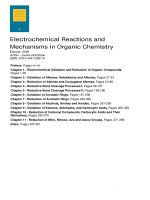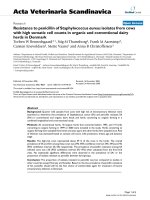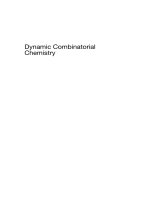Modern tendencies in organic and bioorganic chemistry : today and tomorrow
Bạn đang xem bản rút gọn của tài liệu. Xem và tải ngay bản đầy đủ của tài liệu tại đây (9.23 MB, 435 trang )
www.pdfgrip.com
MODERN TENDENCIES IN ORGANIC
AND BIOORGANIC CHEMISTRY:
TODAY AND TOMORROW
www.pdfgrip.com
www.pdfgrip.com
MODERN TENDENCIES IN ORGANIC
AND BIOORGANIC CHEMISTRY:
TODAY AND TOMORROW
ABDULAKH MIKITAEV
MUKHED KH. LIGIDOV
AND
GENNADY E. ZAIKOV
EDITORS
Nova Science Publishers, Inc.
New York
www.pdfgrip.com
Copyright © 2008 by Nova Science Publishers, Inc.
All rights reserved. No part of this book may be reproduced, stored in a retrieval system or
transmitted in any form or by any means: electronic, electrostatic, magnetic, tape, mechanical
photocopying, recording or otherwise without the written permission of the Publisher.
For permission to use material from this book please contact us:
Telephone 631-231-7269; Fax 631-231-8175
Web Site:
NOTICE TO THE READER
The Publisher has taken reasonable care in the preparation of this book, but makes no expressed or
implied warranty of any kind and assumes no responsibility for any errors or omissions. No
liability is assumed for incidental or consequential damages in connection with or arising out of
information contained in this book. The Publisher shall not be liable for any special,
consequential, or exemplary damages resulting, in whole or in part, from the readers’ use of, or
reliance upon, this material. Any parts of this book based on government reports are so indicated
and copyright is claimed for those parts to the extent applicable to compilations of such works.
Independent verification should be sought for any data, advice or recommendations contained in
this book. In addition, no responsibility is assumed by the publisher for any injury and/or damage
to persons or property arising from any methods, products, instructions, ideas or otherwise
contained in this publication.
This publication is designed to provide accurate and authoritative information with regard to the
subject matter covered herein. It is sold with the clear understanding that the Publisher is not
engaged in rendering legal or any other professional services. If legal or any other expert
assistance is required, the services of a competent person should be sought. FROM A
DECLARATION OF PARTICIPANTS JOINTLY ADOPTED BY A COMMITTEE OF THE
AMERICAN BAR ASSOCIATION AND A COMMITTEE OF PUBLISHERS.
LIBRARY OF CONGRESS CATALOGING-IN-PUBLICATION DATA
Modern tendencies in organic and bioorganic chemistry : today and tomorrow / Abdulakh
Mikitaev, Mukhed Kh. Ligidov, Gennady E. Zaikov (editor).
p. cm.
ISBN 978-1-60692-454-9
1. Chemistry, Organic. 2. Bioorganic chemistry. I. Mikitaev, Abdulakh K. II. Ligidov, Mikhail
Kh. III. Zaikov, Gennadii Efremovich.
QD251.3.M636
2008
547--dc22
2007051490
Published by Nova Science Publishers, Inc.
www.pdfgrip.com
New York
CONTENTS
Preface
Chapter 1
Chapter 2
Chapter 3
Chapter 4
ix
Thermal and Thermal-oxidative Degradation of Polyethylene
Nanocomposite Prepared by Intercalation Polymerization
S. M. Lomakin, L. A. Novokshonova, P. N. Brevnov,
A. N. Shchegolikhin and G. E. Zaikov
Modification of Catalytic Activity of Complexes of
Acetylacetonates Fe(II,III) with Quaternary Ammonium
Salts in the Ethylbenzene Oxidation with
Molecular O2 in the Presence of Small Amounts of H2O
L. I. Matienko and L. A. Mosolova
1
33
Modeling the Kinetics of Moisture Adsorption by
Wood during the Drying Process
A. Farjad, S. H.Rahrovan and A. K. Haghi
51
New Trends, Achievements and Developments on the
Effects of Beam Radiation on Different Materials
K. Mohammadi and A. K. Haghi
65
Chapter 5
Structural Behavior of Composite Materials
О. А. Legonkova, J. L. Gordeeva and E. S. Obolonkova
Chapter 6
Comparative Evaluation of Antioxidant Properties of
Spice-aromatic Plant Essential oils
A. L. Samusenko
103
The Polymeric Compositions Stabilized
Nanodimensions Phosphor Organically by Compounds
A. Kh. Shaov, A. N. Teuvazhukova and A. A. Akezheva
113
Composite Materials for Ortopedical Stomatology
on the Basis of Utilized Glassy Organically
A. Kh. Shaov, E. M. Kushhov and K. A. Sohrokova
117
Chapter 7
Chapter 8
www.pdfgrip.com
89
vi
Chapter 9
Chapter 10
Chapter 11
Chapter 12
Chapter 13
Contents
A Preliminary Study on Antimicrobial Edible
Films from Pectin and Other Food Hydrocolloids
by Extrusion Method
LinShu Liu, Tony Jin, Cheng-Kung Liu, Kevin Hicks,
Amar K. Mohanty, Rahul Bhardwaj and Manjusri Misra
121
Controlled Release of the Antiseptic from
Poly(3-hydroxybutyrate) Films. Combination
of Diffusion and Zero-order Kinetics
R. Yu. Kosenko, Yu. N. Pankova,
A. L. Iordanskii and G. E. Zaikov
139
Photo Composites on the Base of Polymer-monomer
Combined System, Modified by Oligomers
N. V. Sidorenko, I. M. Gres, N. G. Bulycheva,
M. A. Vaniev and I. A. Novakov
Stabilization of Cell Membranes by Hybrid
Antioxidants in Therapy of Neurodegenerative Diseases
L. D. Fatkullina, O. M. Vekshina, E. B. Burlakova,
A. N. Goloshchapov and Yu. A. Kim
Wear Resistant Composite Polymeric Materials
Based on Polyurethanes and Polyisocyanurates
L. V. Luchkina, A. A. Askadsky and V. V. Kazantseva
Chapter 14
Photodestruction of Chlorophyll in Non-biological Systems
A. V. Lobanov, O. V. Nevrova, Yu. A. Vedeneeva,
G. V. Golovina and G. G. Komissarov
Chapter 15
Some Microkinetic Particularities of Deep
Hydrolysis Pet Calcium Gidrokside in Bead Mill
A. S. Harichkin and A. M. Ivanov
147
151
161
165
171
Chapter 16
Transport Phenomena within Porous Media
Sh. Rahrovan and A. K. Haghi
175
Chapter 17
Block-copolysulfonarilates of Polycondensational Type
E. B. Barokova, A. M. Kharaev,
R. Ch. Bazheva and T. R. Umerova
211
Chapter 18
Liguid-crystalline Polyesthers on the Basis of
Terephtaloyl-di(n-oxibenzoat) and Aromatic Polyethers
L. A. Asueva, M. A. Nasurova, G. B. Shustov,
A. M. Kharaev, A. K. Mikitaev
Chapter 19
Fireproof Aromatic Block Copolymer Resin on the
Basis of 1,1- Dichlor-2,2 DI(N-oxyphenyl)ethylene
A. M. Kharaev, R. C. Bazheva, E. B. Barokova,
O. L. Istepanova, R. A. Kharaeva and A. A.Chaika
www.pdfgrip.com
215
219
Contents
Chapter 20
Chapter 21
Chapter 22
Chapter 23
Chapter 24
Chapter 25
Chapter 26
Chapter 27
Chapter 28
Chapter 29
Increase in Selectivity of Molecular Complex
Formation of Metalloporphyrins due to π-π-interactions
Nataliya A. Pavlycheva, Nataliya Sh. Lebedeva,
Anatoliy I. Vyugin and Elena V. Parfenyuk
vii
223
Influence of Individual Components of Essential
Oils and Flavorings on Citral Oxidation
А. L. Samusenko
231
Some Aspects of Dynamic Water Vapour and Heat
Transport through Fabrics
A. K. Haghi
239
A Novel Approach for Measurement of NanoFiber
Diameter of Electrospun Webs
M. Ziabari, V. Mottaghitalab and A. K. Haghi
271
Lasers Application Boundaries to Stimulate
Photochemical Processes
R. H. Chaltykian and N. M. Beylerian
295
Quantum-chemical Analysis of the Mechanism of Nucleophilic
Substitution of Bromine in Methyl(benzyl)bromide
by s-, o-anions Generated from 2-thiouracil
A. V. Babkin, A. I. Rakhimov, E. S. Titova, R. G. Fedunov,
R. A. Reshetnikov, V. S. Belousova and G. E. Zaikov
311
Conformational Behavior of Propagating Chains of
Polyacrylate- and Polymethacrylate
Guanidines in Water Solutions
N. A. Sivov, A. I. Martynenko, Yu. A. Malkanduev,
M. H. Baidaeva, A. A. Zhansitov,
O. A. Taov and A. I. Sarbasheva
Biocide and Toxicological Properties of Synthesized
Guanidine Containing Polymer and their Structure
N. A. Sivov, Yu. A. Malkanduev, S. Yu. Khashirova,
M. H. Baidaeva, A. I. Sarbasheva,
A. A. Zhansitov and O. A. Taov
Co-polymerization of Diallyldimethylammonium Chloride
and Diallylguanidine Acetates on High Conversion
for Creation of New Biocide Materials
N. A. Sivov, Yu. A. Malkanduev, A. I. Sarbasheva,
M. H. Baidaeva and S. Yu. Khashirova
The Approach to Calculation of Different Co-polymers
Composition by NMR1H Spectroscopy Method
N. A. Sivov, M. Yu. Zaremsky, A. N. Sivov, E. V. Chernikova,
D. N. Sivov, A. A. Zhansitov and O. A. Taov
www.pdfgrip.com
325
335
341
345
viii
Chapter 30
Chapter 31
Chapter 32
Chapter 33
Chapter 34
Chapter 35
Chapter 36
Contents
Structure Peculiarities of Guanidine Containing
Monomers on NMR Spectroscopy Data
N. A. Sivov, M. P. Filatova, A. N. Sivov,
A. I. Rebrov, D. N. Sivov and E. B. Pomakhina
Peculiarities of Radical Polymerization Reactions of
Acrylate- and Methacrylate Guanidines
N. A. Sivov, A. I. Martynenko, Yu. A. Malkanduev,
E. Yu. Kabanova, N. I. Popova, A. A. Zhansitov,
O. A. Taov and S. Yu. Khashirova
The Strategy of Ionizing Monomers Synthesis and
Investigation of their Radical Polymerization for
Preparation of New Polyelectrolytes with Useful Properties
N. A. Sivov
Effect of Vibration on Structure and Properties
of Polymeric Membranes
V. N. Fomin, A. P. Bobylev, E. B. Malyukova,
V. V. Smolyaninov, I. A. Arutyunov and N. A. Bulychev
349
353
361
367
One-stage Synthesis of Polymer Flocculant
on the Acrylonitrile Basis
N. V. Kozhevnikov, M. D. Goldfein and N. I. Kozhevnikova
379
Ultrasonic Treatment Assisted Surface Modification of
Inorganic and Organic Pigments in Aqueous Dispersions
N. A. Bulychev, E. V. Kisterev, I. A. Arutunov, and V. P. Zubov
385
Investigation of Antioxidant Activity of Essential Oils from
Lemon, Pink Grapefruit, Coriander, Clove
and its Mixtures by Capillary Gas Chromatography
A. L. Samusenko
Index
397
407
www.pdfgrip.com
PREFACE
“Heroes are born after their death”
Sigmund Freid
Austria
We hope that scientific popularity of those who has taken part in a preparation of the
given compilation book, will come earlier, than it declared Sigmund Freid (see an epigraph).
The present collection of articles is made of reports which have been reported on four
international conferences:
•
•
•
•
The first All-Russia Scientific and Technical Conference “Nanostructures in
polymers and polymeric nanocomposites” (the Kabardino-Balkarian State
University, Nalchik, Russia, June, 2 - 5 2007);
The Thirds All-Russia Scientific conference “New polymeric composite materials”
(the Kabardino-Balkarian State University, June, 6 - 9 2007).
XIIIth International Conference for Renewable Resources and Plant Biotechnology
(Institute of Natural Fibres, Poznan, Poland, June, 18 – 19 2007);
IXth International Conference on Frontiers of Polymers and Advanced Materials
(Cracow University of Technology, Cracow, Poland, July, 8 – 12 2007).
This volume is including information about thermal and thermooxidative degradation of
polyolefine nanocomposites, modeling of catalytic complexes in the oxidation reactions,
modeling the kinetics of moisture adsorption by natural and synthetic polymers, new trends,
achievements and developments on the effects of beam radiation, structural behaviour of
composite materials, comparative evaluation of antioxidants properties, synthesis, properties
and application of polymeric composites and nanocomposites, photodegradation and light
stabilization of polymers, wear resistant composite polymeric materials, some macrokinetic
phenomena, transport phenomena in polymer matrix, liquid crystals, flammability of
polymeric materials and new flame retardants.
We expect that this information will be useful for students, scientists and engineers who
are working in the field of organic and bioorganic chemistry (including monomers, oligomers,
polymers, composites and filled polymers as well as in agriculture and biotechnology).
www.pdfgrip.com
www.pdfgrip.com
In: Modern Tendencies in Organic and Bioorganic Chemistry
ISBN: 978-1-60456-295-8
Editors: A. Mikitaev, M. K. Ligidov, pp. 1-32
© 2008 Nova Science Publishers, Inc.
Chapter 1
THERMAL AND THERMAL-OXIDATIVE DEGRADATION
OF POLYETHYLENE NANOCOMPOSITE
PREPARED BY INTERCALATION POLYMERIZATION
S. M. Lomakin1, L. A. Novokshonova2, P. N. Brevnov2,
A. N. Shchegolikhin1 and G. E. Zaikov1
1
N.M. Emanuel Institute of Biochemical Physics of Russian Academy of Sciences,
119991 Kosygin 4, Moscow, Russia,
2
N.N. Semenov Institute of Chemical Physics of Russian Academy of Sciences,
119991 Kosygin 4, Moscow, Russia
ABSTRACT
A comparative study of thermal and thermal-oxidative degradation processes for
polyethylene/organically modified montmorillonite (PE-MMT) nanocomposites,
prepared by the ethylene intercalative polymerization in situ with or without subsequent
addition of an antioxidant, is reported. The results of TGA and time/temperature
dependent FTIR spectroscopy experiments have provided evidence for an accelerated
formation and decomposition of hydroperoxides during the thermal oxidative degradation
tests of PE-MMT nanocomposites in the range of 170-200oC as compared to the unfilled
PE, thus indicating to a catalytic action of MMT. It has been shown that effective
formation of intermolecular chemical cross-links in the PE-MMT nanocomposite has
ensued above 200oC as the result of recombination reactions involving the radical
products of hydroperoxides decomposition. Apparently, this process is induced by the
oxygen deficiency in PE-MMT nanocomposite due to its lowered oxygen permeability. It
is shown that the intermolecular cross-linking and dehydrogenation reactions followed by
the shear carbonization lead to appreciable increase of thermal-oxidative stability of PE
nanocomposite as compared to that of pristine PE. Notably, the TGA traces for the
antioxidant-stabilized PE-MMT nanocomposites recorded in air were quite similar to
those obtainable for the non-stabilized PE-MMT nanocomposites in argon. The results of
treatment of the experimentally acquired TGA data in frames of an advanced model
kinetic analysis are reported and discussed.
www.pdfgrip.com
2
S. M. Lomakin, L. A. Novokshonova, P. N. Brevnov et al.
Keywords: Catalysis; intercalation polymerization; kinetics; layered clay; nanocomposite;
oxidation; polyethylene; thermal degradation
1. INTRODUCTION
Polyethylene (PE), being the most commercially important thermoplastic commodity, is
heavily used for consumer products in many applications, but in a number of cases general
applicability of PE turns out to be undermined by its relatively low thermal stability and
flame resistance. The concept of compounding polymer matrices with nanoscale fillers (in
particular, clays or layered silicates) has already been proved to be an effective method of
preparing nanocomposites with excellent physicochemical properties [1 – 11]. It is believed
that, in the course of high temperature pyrolysis and/or combustion, clay nanoparticles are
capable of promoting formation of protective clay-reinforced carbonaceous char which is
responsible for the reduced mass loss rates, and hence the lower flammability. Accordingly,
considerable attention has been paid also to polyolefin/layered silicate nanocomposites.
Reportedly, the latter have exhibited improved mechanical properties, gas impermeability,
thermal stability, and flame retardancy as compared with corresponding pristine polymers
[4,5,9,10].
This study deals with polyethylene/layered silicate nanocomposites that can be prepared
by intercalative polymerization route. In accordance with the latter [12], the polymer chains
growing within the interlayer spacing of montmorillonite (MMT) should be able to exfoliate
the original MMT particles down to the nanoscale inorganic monolayers. Here, an
experimental study of the universal intercalative approach, involving in the particular case (1)
intercalation of a metallorganic catalyst system into the interlayer spacing of organically
modified MMT and (2) subsequent polymerization of ethylene on thus intercalated catalyst,
will be reported as well as the properties of the correspondingly produced PE/MMT
nanocomposites will be discussed.
To clarify the mechanisms of the clay-reinforced carbonaceous char formation, which
may be responsible for the reduced mass loss rates, and hence the lower flammability of the
polymer matrices, a number of thermo-physical characteristics of the PE/MMT
nanocomposites have been measured in comparison with those of the pristine PE (which, by
itself is not a char former) in both inert and oxidizing atmospheres. The evolution of the
thermal and thermal-oxidative degradation processes in these systems was followed
dynamically with the aid of TGA and FTIR methods. Proper attention was paid also to the
effect of oxygen on the thermal-oxidative stability of PE nanocomposites in their solid state,
in both the absence as well as in the presence of an antioxidant. Several sets of experimentally
acquired TGA data have provided a basis for accomplishing thorough model-based kinetic
analyses of thermal and thermal-oxidative degradation of both pristine PE and PE/MMT
nanocomposites prepared in this work.
www.pdfgrip.com
Thermal and Thermal-oxidative Degradation of Polyethylene Nanocomposite …
3
2. EXPERIMENTAL
2.1. Materials
A Cloisite 20A (purchased from Southern Clay Products, Inc.) has been used as the
organically modified montmorillonite (MMT) to prepare PE/MMT nanocomposites
throughout this study. The content of an organic cation-exchange modifier, N+2CH32HT
(HT=hydrogenated tallow, C18≈65%; C16≈30%; C14≈5%; anion: Cl-), in the MMT was of
38 % by weight. VCl4 (vacuum distilled at 40°С before use, TU 48-05-50-71) and Al(i-Bu)3
(Aldrich) have been used for catalytic activation of MMT. Ethylene monomer was of a
standard polymerization grade.
2.2. Procedure of Polyethylene Nanocomposite Synthesis
Intercalation of the catalyst has been accomplished by treating the freshly dehydrated
MMT with Al(i-Bu)3 and then with VCl4. The polymerization reaction was started by
admitting ethylene into the reactor and then was carried out until desired amount of PE
nanocomposite (PE-n-MMT) was obtained. The polymerization reaction was stopped by
adding ethanolic HCl solution (5 wt % HCl) to the reactor. The polymer composite product
was filtered off, washed with ethanol and dried under vacuum at 60°C. The weight loads of
MMT in the resulting composites were calculated by neglecting the contribution of the
organic modifier in MMT.
The sample of unfilled polyethylene (PE) was prepared by ethylene polymerization on
VCl3 activated with Al(i-Bu)3 at the same conditions as applied to the nanocomposite
synthesis.
Stabilized samples of both the nanocomposites (st-PE-n-MMT) and pristine PE (st-PE)
were prepared by treating them with synergetic composition of Topanol CA and di-lauryl3,3’-thiodipropionate (DLTDP) solutions in heptane [Voigt J., Die Stabilisierung der
Kunstoffe Gegen Licht und Wärme, Springer-Verlag, Berlin-Heidelberg-New York, 1966,
p.542] at 70°C, followed by drying in vacuum. The concentrations of Topanol and DLTDP in
(st-PE-n-MMT) and (st-PE) comprised 0.3 and 0.5 wt.%, respectively.
For further testing, the prepared materials were hot-pressed into films at applied pressure
of 20 MPa and 160°С.
2.3. Characterization of Materials
Small-angle X-ray Scattering (SAXS)
The structure of the composites was studied by SAXS using a KRM-1 camera (Cu Kα
radiation, λ = 0.154 nm, Ni filter). The test samples were powders or films. The data collected
were normalized with due regard to the concentration of MMT and the coefficients of
attenuation.
www.pdfgrip.com
4
S. M. Lomakin, L. A. Novokshonova, P. N. Brevnov et al.
Transmission Electron Microscopy (TEM).
Micrograph of PE nanocomposite sample was obtained on a JEM-100B transmission
electron microscope at an accelerating voltage of 80 kV. The sample of 70 nm thickness was
cut with the aid of LKV-III ultramicrotome from the composite plate prepared by hot
pressing.
Thermogravimetric Analysis (TGA)
A Perkin-Elmer TGA-7 instrument calibrated by Curie points of several metal standards
has been employed for non-isothermal thermogravimetric analysis. The measurements were
carried out at a desired heating rate (in the range of 3 – 40 K/min) in both inert (argon) and
oxidizing (oxygen) atmospheres, as appropriate.
Fourier Transform Infrared (FTIR) Spectroscopy
Infrared spectra of the investigated materials in their nascent form were acquired with the
aid of a Perkin-Elmer 1725X FTIR instrument by using a Spectra-Tech "Collector" DRIFT
accessory furnished with a heated sample post, embedded thermo couple and the
corresponding external heater/controller providing temperature reading precision of ±1.0C.
The series of FTIR spectra for the polymer samples have been recorded at systematically
varied temperatures or over predetermined time intervals (in isothermal regimes) by
employing a modified diffuse reflectance-absorbance Fourier Transform (DRAFT)
spectroscopy technique published elsewhere [13]. All measurements were performed using
the instrument DTGS detector and a 4cm-1 resolution.
Kinetic analysis of PE compositions thermal degradation was carried out using
Thermokinetics software by NETZSCH-Gerätebau GmbH.
3. RESULTS AND DISCUSSION
3.1. Morphology (Structure Evaluation)
Small-angle X-ray scattering (SAXS) has been used to evaluate the degree of exfoliation
of the organoclay particles in the polymer matrix [12]. SAXS diffractograms of pristine C20A
MMT and those of PE nanocomposites prepared by the intercalation polymerization route for
MMT contents of 2.0 vol. % (2) and 6.5 vol. % (3) are shown in Figure 1. The SAXS curve
for C20A MMT shows a reflection at around of 3.6o corresponding to the interlayer mean
distance of 2.46 nm (Figure 1, 1). As can be seen from the same Figure 1 (2, 3), for the
PE/clay nanocomposites having different MMT contents, the 3.6o reflection is absent. This
result infers that PE chains, while growing in the course of polymerization in the interlayer
spacing of the layered filler particles, are able to commit full exfoliation of the MMT particles
down to the monolayers.
www.pdfgrip.com
Intensity, cps
Thermal and Thermal-oxidative Degradation of Polyethylene Nanocomposite …
5
3
2
1
0
2
4
6
8
2θ, degrees
Figure 1. SAXS patterns for the original C20A MMT (1) and PE nanocomposites with MMT content of
2.0 vol. % (2) and 6.5 vol. % (3)
Figure 2 shows TEM image of the PE nanocomposite containing 1 vol. % of MMT. The
dark features in the micrograph correspond to the exfoliated monolayers and nanostacks of
MMT distributed throughout the PE matrix. It can be seen that the nanoscale MMT layers
lack any sort of orientation in the matrix of the pressed composite. Moreover, the exfoliated
MMT particles exhibit a very high aspect ratio (longitudinal size: thickness).
Figure 2. TEM micrograph of the PE nanocomposite containing 1% by volume of MMT.
www.pdfgrip.com
S. M. Lomakin, L. A. Novokshonova, P. N. Brevnov et al.
Intensity, cps
6
1
2
0
2
4
6
8
2θ, degrees
Figure 3. SAXS patterns for the original C20A MMT (1) and C20A MMT treated with HCl solution in
ethanol (5 wt % HCl) (2).
It is worth noting here that the organic ammonium cations present in pristine C20A MMT
are susceptible to washing out from the interlayer spacing of MMT under acidic treatment of
the latter with ethanolic HCl (5% by wt.). The ammonium cations are substituted for protons,
and this leads to a prominent decrease of the interlayer distances in the MMT structure
(Figure 3). If the intercalative polymerization of ethylene would not accomplish exfoliation of
the MMT particles in the composite to the full extent, the diffractogram should contain a wide
reflection positioned somewhere at greater angles than in the pristine C20A MMT. It is
obvious also that the acidic after-treatment of the synthesized exfoliated nanocomposites
should lead to removal of the major part of the original organic MMT modifier.
3.2. Thermal Degradation of PE Nanocomposite
It is generally accepted that thermal stability of polymer nanocomposites is higher than
that of pristine polymers, and that this gain is explained by the presence of anisotropic clay
layers hindering diffusion of volatile products through the nanocomposite material. It is
important to note that the exfoliated nanocomposites, prepared and investigated in this work,
had much lower gas permeability in comparison with that of pristine unfilled PE [12]. Thus,
the study of purely thermal degradation process of PE nanocomposite seemed to be of interest
in terms of estimation of the nanoclay barrier effects on thermal stability of polyolefin/clay
nanocomposites.
The radical mechanism of thermal degradation of pristine PE has been widely discussed
in a framework of random scission type reactions [14-22]. It is known that PE decomposition
products comprise a wide range of alkanes, alkenes and dienes. Branching of PE chains
causes enhanced intermolecular hydrogen transfer and results in lowering thermal stability.
The polymer matrix transformations, usually observed at lower temperatures and involving
www.pdfgrip.com
Thermal and Thermal-oxidative Degradation of Polyethylene Nanocomposite …
7
molecular weight alteration without formation of volatile products, are principally due to the
scission of weak links, e. g. oxygen bridges, incorporated into the main chain as impurities.
The kinetics of thermal degradation of PE is frequently described by a first-order model of
mass conversion of the sample [21]. A broad variation in Arrhenius parameters can be found
in literature, i. e., activation energy (E) ranging from 160 to 320 kJ/mol and pre-exponential
factor (A) variations in the range of 1011 and 1021 s-1 [20-22] are not unusual. It is believed
that the broad range of E values reported may be explained by the polymers molecular mass
variations, by use of various additives, and by different experimental conditions [22]
employed by different authors.
Previously Bockhorn et al. have reported that thermal degradation of PE leads to a large
number of paraffins, dienes and olefins without a residue formation [20]. Analysis of the
pyrolysis products with GC-MS revealed high yields of linear n-alkanes and n-alkenes.
Neither branched aliphatics, alicyclics or aromatic compounds nor Diels-Alder derivatives of
butadiene have been detected [20]. In order to formulate a simple kinetic model adequately
explaining the isothermic global kinetic data of the authors, a mechanism embracing only the
main reactions has been proposed [20]. The latter is based on a radical chain mechanism
(Scheme 1) initiated by random scission of the polymer chains into primary radicals Rp (1). βScission of these radicals leads to ethylene (2). At higher temperatures, the unzip reaction
leading to ethylene becomes more evident [15]. At low temperatures, intramolecular
hydrogen transfer followed by β-scission occurs (3). This reaction leads to the more stable
secondary radicals Rs. The 1,5 rearrangement reaction (3) in Scheme 1 stands for all preferred
rearrangement reactions via cyclic intermediates such as 1,9, 1,13, 1,17, etc. Subsequent βscission of the secondary radicals contributes to the radical chain mechanism because the
primary radical is produced in each step (propagation). Two β-scission reactions (4, 4’) are
possible. Reaction (4) leads to alkenes, whereas reaction (4’) leads to a short primary radical
and a polymer with a terminal double bond. It is important that the change in the reaction
order is dependent on the intermolecular hydrogen transfer in reaction (5) leading to the
alkanes. In this case only the intermolecular hydrogen transfer of the primary radicals is
considered because the latter are less stable than the secondary radicals. At high temperatures
and at a high degrees of conversion, the alkanes formation via reaction 5 becomes favored
and, therefore, the reaction order alters from 0.5 to 1.5 [20].
In the present work, the processes of thermal degradation of both unstabilized PE and
PE-n-MMT nanocomposite with MMT content of 4.3 wt.% have been investigated by TGA
in an inert (argon) atmosphere at the heating rates of 3, 5, 10 and 20 K/min. According to the
dynamic TGA data, the polymer degradation starts at about 300°C and then, through a
complex radical chain process (Scheme 1), the material totally destructs and completely
volatilizes in the range of 500-550oC (Figure 4). It is obvious that, taken at the same heating
rates in argon, the thermograms for pristine PE and PE-n-MMT are practically identical,
except that the solid silicate residue amounting to 4-5 % wt. can be seen on the curves for the
nanocomposites (Figure 4). This result suggests that the mechanisms of thermal degradation
of PE and PE-n-MMT nanocomposites, and hence the global kinetic parameters of their
thermal degradation processes are rather similar.
www.pdfgrip.com
8
S. M. Lomakin, L. A. Novokshonova, P. N. Brevnov et al.
Initiation
H2
C
H2
C
C
H2
C
H2
C
H2
H2
C
H2
C
k1
+
C
H2
C
H2
H2
C
C
H2
C
H2
(1)
H 2C
CH2
(2)
2RP
P
Propagation
H2
C
H2
C
C
H2
C
H2
H2
C
k2
C
H2
C
H2
C
H2
RP
+
RP
Hydrogen transfer (intramolecular)
H2
C
H2
C
H2
C
C
H2
C
H2
C
H2
H2
C
k3
H2
C
C
H2
C
H2
C
H2
C
H2
CH3
β-scission
H2
C
k4
C
H
H2
C
(3)
Rs
RP
H2
C
C
H
C
H2
CH3
C
H2
C
H2
H 2C
RP
H2
C
C
H2
+
H2
C
H
C
(4)
3)
alkene/diene
k 4'
H2
C
Rs
CH3
C
H
C
H2
+
CH2
C
H2
P
H2
C
(4')
CH3
RP
Hydrogen transfer (intermolecular)
H2
C
H 3C
n C
H2
C
+
H2
H2
C
RP
n C
H 3C
C
H2
C
H2
H2
C
k5
H2
alkane
P
CH3
+
H
C
C
H2
C
H2
(5)
)
Rs
Termination -2nd order (recombination)
H2
C
RP
+
k6
H2
C
RP
Scheme 1. Mechanism of PE thermal degradation [20].
www.pdfgrip.com
C C
H2 H2
P
(6)
)
Thermal and Thermal-oxidative Degradation of Polyethylene Nanocomposite …
9
100
Weight, %
80
3
60
1
40
2
4
20
0
200
300
400
500
600
o
Temperature, C
Figure 4. TGA thermograms for PE (firm lines) and PE-n-MMT (dotted lines) taken in Ar at the heating
rates of: 3K/min - 1, 2 and 10K/min. - 3, 4.
3.3. Kinetic Analysis of PE Nanocomposite Thermal Degradation Based on
TGA Data
Kinetic studies of materials degradation have long history, and there exists a long list of
data analysis techniques employed for the purpose. Often, TGA is the method of choice for
acquiring experimental data for subsequent kinetic calculations, and namely this technique
was employed here.
It is commonly accepted that the degradation of materials follows the base equation (1)
[15].
dc/dt = - F(t,T co cf)
(1)
where: t - time, T - temperature, co - initial concentration of the reactant, and cf concentration of the final product. The right-hand part of the equation F(t,T,co,cf) can be
represented by the two separable functions, k(T) and f(co,cf):
F(t,T,co,cf) = k[T(t)·f(co,cf)]
(2)
Arrhenius equation (4) will be assumed to be valid for the following:
k(T) = A·exp(-E/RT)
(3)
www.pdfgrip.com
10
S. M. Lomakin, L. A. Novokshonova, P. N. Brevnov et al.
Therefore,
dc/dt= - A·exp(-E/RT)·f(co,cf )
(4)
All feasible reactions can be subdivided onto classic homogeneous reactions and typical
solid state reactions, which are listed in Table 1 [23]. The analytical output must provide good
fit to measurements with different temperature profiles by means of a common kinetic model.
Kinetic analysis of PE and PE-n-MMT thermal degradation at heating rates of 3, 5, 10
and 20K/min was accomplished by using a NETZSCH Thermokinetics software in
accordance with a formalism we proposed earlier [7].
In order to assess the activation energy for development of a reasonable model for kinetic
analysis of pristine PE and PE-n-MMT thermal degradation processes, a few evaluations by
model-free methods have been done as the starting point. As an example, the results of a
model-free Friedman analysis for thermal degradation of PE, where the activation energy is a
function of partial mass loss change [24], are shown in Figure 5.
Table 1. Reaction types and corresponding reaction equations, dc/dt= - A·exp(E/RT)·f(co,cf )
Name
F1
F2
Fn
f(co,cf )
c
c2
cn
Reaction type
first-order reaction
second-order reaction
nth-order reaction
R2
R3
2 · c1/2
3 · c2/3
two-dimensional phase boundary reaction
three-dimensional phase boundary reaction
D1
D2
D3
D4
0.5/(1 - c)
-1/ln(c)
1.5 · e1/3(c-1/3 - 1)
1.5/(c-1/3 - 1)
one-dimensional diffusion
two-dimensional diffusion
three-dimensional diffusion (Jander's type)
three-dimensional diffusion (Ginstling-Brounstein type)
B1
Bna
co · cf
con · cfa
simple Prout-Tompkins equation
expanded Prout-Tompkins equation (na)
C1-X
c · (1+Kcat · X)
first-order reaction with autocatalysis through the reactants,
X. X = cf.
Cn-X
cn · (1+Kcat · X)
nth-order reaction with autocatalysis through the reactants, X
A2
A3
An
2 · c · (-ln(c))1/2
3 · c · (-ln(c))2/3
N · c · (-ln(c))(n-
two-dimensional nucleation
three-dimensional nucleation
n-dimensional nucleation/nucleus growth according to
Avrami/Erofeev
1)/n
www.pdfgrip.com
Thermal and Thermal-oxidative Degradation of Polyethylene Nanocomposite …
E, kJ/
mol
11
log
(A,s-1)
2
35
1
25
1
15
5
0
5
0
0.
0.
Conversion degree
0.
0.
1.
Figure 5. The graphs for activation energy and pre-exponential factor as the functions of the conversion
degree (partial mass loss) for thermal degradation of PE in argon, obtained with the aid of Friedman
analysis.
Further, nonlinear model fitting procedure for PE and PE-n-MMT TGA-curves has led to
the following triple-stage model scheme of successive reactions (Figure 6 a, b):
Dn
A
Fn
B
C
Fn
D
(5)
Taking this as a reasonable approximation for PE and PE-n-MMT, the fits with the aid of
nonlinear regression were attempted by the model (5), where an one-dimensional diffusion
type reaction was used for the first step and the nth-order (Fn) reaction - for the two
subsequent steps of the overall thermal degradation process (Figure 6, Table 1).
Assuming a radical chain mechanism is operative in the process of PE and PE-n-MMT
thermal degradation (Scheme 1), the apparent activation energy and the pre-exponential factor
values calculated in this work turned out to be in perfect match with the data from isothermal
analysis and dynamic TGA published earlier (Ea = 268 ± 3 kJ/mol, log A = 17.7 ± 0.01 min-1
and Ea = 262.1 kJ/mol, log A = 18.09± 0.14 min-1 [25].)
www.pdfgrip.com
12
S. M. Lomakin, L. A. Novokshonova, P. N. Brevnov et al.
a
100
80
3
Weight, %
2
4
1
60
40
20
0
200
300
400
500
600
o
Temperature, C
b
100
80
3
2
Weight, %
4
1
60
40
20
0
200
300
400
500
600
o
Temperature, C
(b)
Figure 6. Outcome of multiple models-based nonlinear fitting for pristine PE (a) and PE-n-MMT (b).
The experimental TGA-data (dots) in comparison with the model calculations results (firm lines) are
shown for different heating rates: 3K/min – (1), 5K/min – (2), 10K/min – (3) and 20K/min – (4).
www.pdfgrip.com
Thermal and Thermal-oxidative Degradation of Polyethylene Nanocomposite …
13
Table 2. The kinetic parameters for the three-step thermal degradation of PE and PE-nMMT as obtained by the multiple-curve analysis of the experimental TGA-data
(heating rates 3, 5, 10 and 20 K/min) in frames of the reaction model
Fn
Dn
Fn
A
Material
PE
PE-n-MMT
B
C
Parameter
Value
logA1, s-1
E1, kJ/mol
11.7
197.7
logA2, s-1
E2, kJ/mol
n2
15.5
253.1
0.50
logA3, s-1
E3, kJ/mol
n3
16.6
268.1
1.50
logA1, s-1
E1, kJ/mol
10.3
186.3
logA2, s-1
E2, kJ/mol
n2
14.5
237.5
0.50
logA3, s-1
E3, kJ/mol
n3
17.6
274.3
1.50
D
Corr. Coeff.
0.9994
0.9992
The TGA data acquired for PE and PE-n-MMT in argon has not provided any evidence in
favour of the hypothesis that the barrier effect, being clearly manifested in the gas
permeability experiments with the same PE-n-MMT at room temperature [12], is operative
also during thermally stimulated degradation of PE-n-MMT. It should be noted that, in an
inert atmosphere, degradation/volatilization of both PE and PE-n-MMT starts at about 350°C
and is totally completed upto 500-550oC, not taking into account a solid silicate residue
amounting to 4-5 % wt. which remains in the case of the nanocomposites (Figure 4, 6). Based
on TGA data, the first stage of the degradation process (1D-diffusion limiting stage) develops
in the range of 350-410oC corresponding to the overall mass loss of 5-7%. The subsequent
steps of the thermal degradation processes (410 - 500oC) for PE and PE-n-MMT proceed in
the liquid melt of high molecular weight degradation products (Scheme 1). In the light of the
above findings, we believe that during the high-temperature degradation stages (above, e. g.,
410oC) in an inert atmosphere, the barrier diffusion restrictions can become insignificant
since the viscosity of the pyrolyzed polymer melt at these temperatures is rather low and,
because of the intensified mobility of the clay layers in such melt, the overall ‘labyrinth
effect’ normally provided by the clay particles in more viscous matrices may be considerably
diminished.
www.pdfgrip.com









